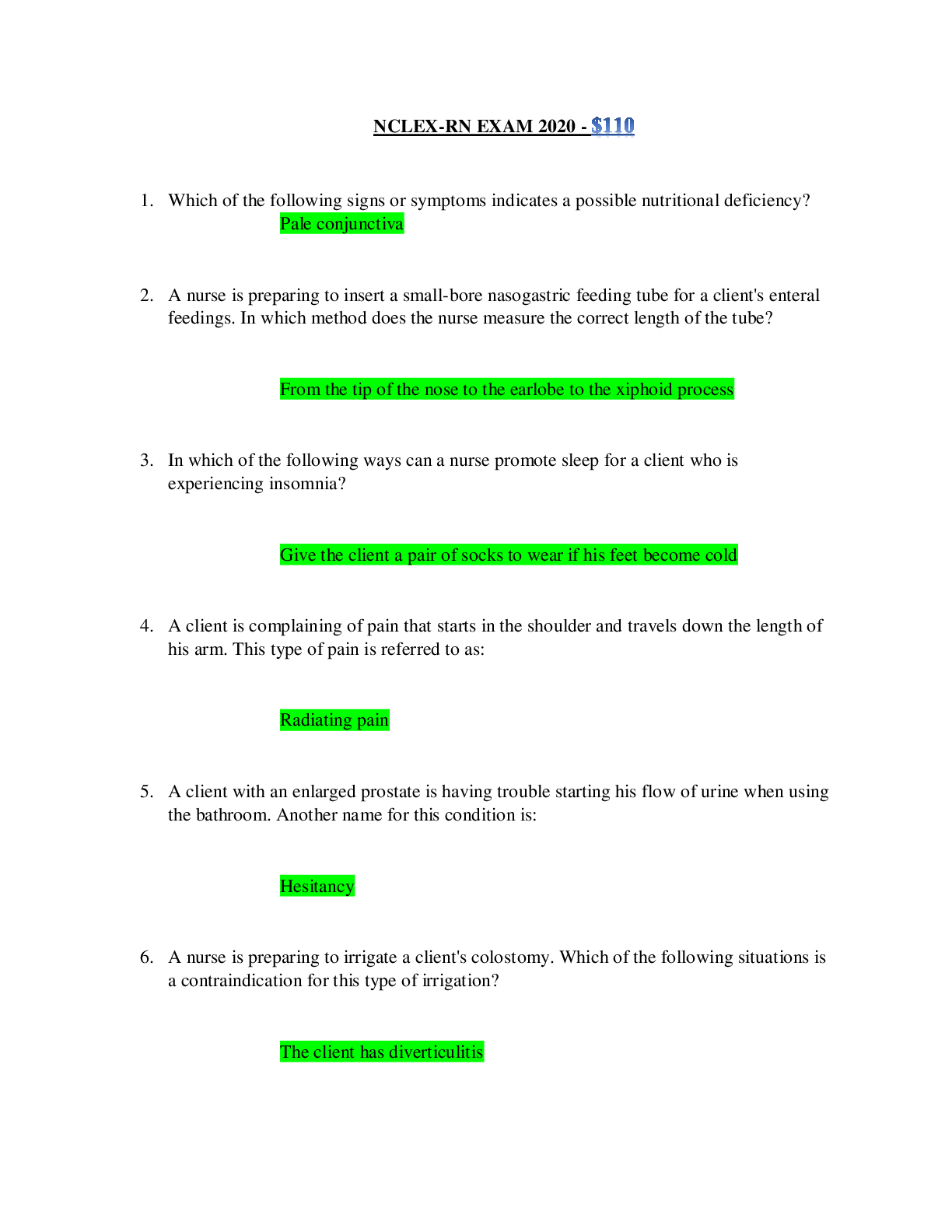*NURSING > NCLEX-RN > C H A P T E R 1 6 Positioning Clients: From Saunders Comprehensive Review for the NCLEX-RN Examinati (All)
C H A P T E R 1 6 Positioning Clients: From Saunders Comprehensive Review for the NCLEX-RN Examination 8th Edition. (Available: https://bit.ly/2HeJuMt ). Contains Practice questions and Answers with the Rationale, Test-Taking Strategy, Level of Cognitive Ability, Client Needs, Integrated Process, Content Area, Health Problem, Priority Concepts and Reference
Document Content and Description Below
C H A P T E R 1 6 Positioning Clients Priority Concepts Mobility; Safety For reference throughout the chapter, please see Figure 16-1, 16-2, 16-3, and 16-4. I. Guidelines for Positioning A. Clien... t safety and comfort 1. Position client in a safe and appropriate manner to provide safety and comfort. 2. Select a position that will prevent the development of complications related to an existing condition, prescribed treatment, or medical or surgical procedure. B. Ergonomic principles related to body mechanics (Box 16- 1) Always review the primary health care provider’s (PHCP’s) or surgeon’s prescription, especially after treatments or procedures, and take note of instructions regarding positioning and mobility. II. Positions to Ensure Safety and Comfort A. Integumentary system 1. Autograft: After surgery, the site is immobilized usually for 3 to 7 days, or as prescribed, to provide the time needed for the graft to adhere and attach to the wound bed. 2. Burns of the face and head: Elevate the head of the bed to prevent or reduce facial, head, and tracheal edema. 3. Circumferential burns of the extremities: Elevate the extremities above the level of the heart to prevent or reduce dependent edema. 5084. Skin graft: Elevate and immobilize the graft site to prevent movement and shearing of the graft and disruption of tissue; avoid weight-bearing. B. Reproductive system 1. Mastectomy a. Position the client with the head of the bed elevated at least 30 degrees (semiFowler’s position), with the affected arm elevated on a pillow to promote lymphatic fluid return after the removal of axillary lymph nodes. b. Turn the client only to the back and unaffected side. 2. Perineal and vaginal procedures: Place the client in the lithotomy position. C. Endocrine system 1. Hypophysectomy: Elevate the head of the bed to prevent increased intracranial pressure. 2. Thyroidectomy a. Place the client in the semiFowler’s to Fowler’s position to reduce swelling and edema in the neck area. b. Sandbags or pillows or other stabilization devices may be used to support the client’s head or neck. c. Avoid neck extension to decrease tension on the suture line. D. Gastrointestinal system 1. Hemorrhoidectomy: Assist the client to a lateral (sidelying) position to prevent pain and bleeding. 2. Gastroesophageal reflux disease: Reverse Trendelenburg’s position may be prescribed to promote gastric emptying and prevent esophageal reflux. 3. Liver biopsy (see Priority Nursing Actions) Priority nursing actions Liver Biopsy 1. Explain the procedure to the client. 2. Ensure that informed consent has been obtained. 3. Position the client supine, with the right side of the upper abdomen exposed; the client’s right arm is raised and extended behind the head and over the left shoulder. 4. Remain with the client during the procedure. 5095. After the procedure, assist the client into a right lateral (sidelying) position and place a small pillow or folded towel under the puncture site. 6. Monitor vital signs closely after the procedure and monitor for signs of bleeding. 7. Document appropriate information about the procedure, client’s tolerance, and postprocedure assessment findings. Reference Lewis et al. (2017), p. 850. 4. Paracentesis: Client is usually positioned in a semiFowler’s position in bed, or sitting upright on the side of the bed or in a chair with the feet supported; client is assisted to a position of comfort after the procedure. 5. Nasogastric tube a. Insertion: Position the client in a highFowler's position with the head titled forward; this position will help close the trachea and open the esophagus. b. Irrigation and tube feedings: Elevate the head of the bed (semi-Fowler’s to Fowler’s position) to prevent aspiration; head elevation is maintained for 30 minutes to 1 hour (per agency procedure) after an intermittent feeding and should remain elevated for continuous feedings. If the client receiving a continuous tube feeding needs to be placed in a supine position when providing care, such as when giving a bed bath or changing linens, shut off the feeding to prevent aspiration. Remember to turn the feeding back on and check the rate of flow when the client is placed back into the semi-Fowler’s or Fowler’s position. 6. Rectal enema and irrigations: Place the client in the left Sims’ position to allow the solution to flow by gravity in the natural direction of the colon. 7. Sengstaken-Blakemore and Minnesota tubes a. Not commonly used because they are uncomfortable for the client and can cause complications, but their use may be necessary when other interventions are not feasible. b. If prescribed, maintain elevation of the 510head of the bed to enhance lung expansion and reduce portal blood flow, permitting effective esophagogastric balloon tamponade. E. Respiratory system 1. Chronic obstructive pulmonary disease: In advanced disease, place the client in a sitting position, leaning forward, with the client’s arms over several pillows or an overbed table; this position will assist the client to breathe easier. 2. Laryngectomy (radical neck dissection): Place the client in a semi-Fowler’s or Fowler’s position to maintain a patent airway and minimize edema. 3. Bronchoscopy postprocedure: Place the client in a semi-Fowler’s position to prevent choking or vaspiration resulting from an impaired ability to swallow. 4. Postural drainage: The lung segment to be drained should be in the uppermost position; Trendelenburg’s position may be used. 5. Thoracentesis a. During the procedure, to facilitate removal of fluid from the pleural space, position the client sitting on the edge of the bed or examining table and leaning over a bedside table with the feet supported on a stool, or lying on the unaffected side with the client in Fowler’s position. b. After the procedure, assist the client to a position of comfort. Always check the PHCP’s prescription regarding positioning for the client who had a thoracotomy, lung wedge resection, lobectomy of the lung, or pneumonectomy. F. Cardiovascular system 1. Abdominal aneurysm resection a. After surgery, limit elevation of the head of the bed to 45 degrees to avoid flexion of the graft. b. The client may be turned from side to side. 2. Amputation of the lower extremity 511a. During the first 24 hours after amputation, elevate the foot of the bed (the residual limb is supported with pillows but not elevated because of the risk of flexion contractures) to reduce edema. b. Consult with the PHCP and, if prescribed, position the client in a prone position twice a day for a 20- to 30-minute period to stretch muscles and prevent flexion contractures of the hip. 3. Arterial vascular grafting of an extremity a. To promote graft patency after the procedure, bed rest usually is maintained for approximately 24 hours, and the affected extremity is kept straight. b. Limit movement and avoid flexion of the hip and knee. 4. Cardiac catheterization a. If the femoral vessel was accessed for the procedure, the client is maintained on bed rest for 4 to 6 hours (time for bed rest may vary depending on PHCP preference and if a vascular closure device was used); the client may turn from side to side. b. The affected extremity is kept straight and the head is elevated no more than 30 degrees (some PHCPs prefer a lower head position or the flat position) until hemostasis is adequately achieved. 5. Heart failure and pulmonary edema: Position the client upright, preferably with the legs dangling over the side of the bed, to decrease venous return and lung congestion. Most often, clients with respiratory and cardiac disorders should be positioned with the head of the bed elevated. 6. Peripheral arterial disease 512a. Obtain the PHCP’s prescription for positioning. b. Because swelling can prevent arterial blood flow, clients may be advised to elevate their feet at rest, but they should not raise their legs above the level of the heart, because extreme elevation slows arterial blood flow; some clients may be advised to maintain a slightly dependent position to promote perfusion. 7. Deep vein thrombosis a. If the extremity is red, edematous, and painful, traditional heparin sodium therapy may be initiated. Bed rest with leg elevation may also be prescribed for the client. b. Clients receiving low-molecular-weight heparin usually can be out of bed after 24 hours if pain level permits. 8. Varicose veins: Leg elevation above heart level usually is prescribed; the client also is advised to minimize prolonged sitting or standing during daily activities. 9. Venous insufficiency and leg ulcers: Leg elevation usually is prescribed. G. Sensory system 1. Cataract surgery: Postoperatively, elevate the head of the bed (semi-Fowler’s to Fowler’s position) and position the client on the back or the nonoperative side to prevent the development of edema at the operative site. 2. Retinal detachment a. If the detachment is large, bed rest and bilateral eye patching may be prescribed to minimize eye movement and prevent extension of the detachment. b. Restrictions in activity and positioning after repair of the detachment depends on the PHCP’s preference and the surgical procedure performed. H. Neurological system 1. Autonomic dysreflexia: Elevate the head of the 513bed to a high-Fowler’s position to assist with adequate ventilation and assist in the prevention of hypertensive stroke. If autonomic dysreflexia occurs, immediately place the client in a high-Fowler’s position. 2. Cerebral aneurysm: Bed rest is maintained with the head of the bed elevated 30 to 45 degrees to prevent pressure on the aneurysm site. 3. Cerebral angiography a. Maintain bed rest for the length of time as prescribed. b. The extremity into which the contrast medium was injected is kept straight and immobilized for about 6 to 8 hours. 4. Stroke (brain attack) a. In clients with hemorrhagic strokes, the head of the bed is usually elevated to 30 degrees to reduce intracranial pressure and to facilitate venous drainage. b. For clients with ischemic strokes, the head of the bed is usually kept flat. c. Maintain the head in a midline, neutral position to facilitate venous drainage from the head. d. Avoid extreme hip and neck flexion; extreme hip flexion may increase intrathoracic pressure, whereas extreme neck flexion prohibits venous drainage from the brain. 5. Craniotomy a. The client should not be positioned on the site that was operated on, especially if the bone flap has been removed, because the brain has no bony covering on the affected site. b. Elevate the head of the bed 30 to 45 degrees and maintain the head in a midline, neutral position to facilitate venous drainage from the head. 514c. Avoid extreme hip and neck flexion. 6. Laminectomy and other vertebral surgery a. Clients are often out of bed postoperatively with a back brace if prescribed. b. When the client is out of bed, the client’s back is kept straight (the client is placed in a straight-backed chair) with the feet resting comfortably on the floor. 7. Increased intracranial pressure a. Elevate the head of the bed 30 to 45 degrees and maintain the head in a midline, neutral position to facilitate venous drainage from the head. b. Avoid extreme hip and neck flexion. Do not place a client with a head injury in a flat or Trendelenburg’s position because of the risk of increased intracranial pressure. 8. Lumbar puncture a. During the procedure, assist the client to the lateral (side-lying) position, with the back bowed at the edge of the examining table, the knees flexed up to the abdomen, and the neck flexed so that the chin is resting on the chest. b. After the procedure, place the client in the supine position for 4 to 12 hours, as prescribed. 9. Spinal cord injury a. Immobilize the client on a spinal backboard, with the head in a neutral position, to prevent incomplete injury from becoming complete. b. Prevent head flexion, rotation, or extension; the head is immobilized with a firm, padded cervical collar. c. Logroll the client; no part of the body should be twisted or turned, nor should the client be allowed to assume a sitting position. I. Musculoskeletal system 1. Total hip replacement 515a. Positioning depends on the surgical techniques used (anterior or posterior approach), the method of implantation, the prosthesis, and surgeon’s preference. b. Avoid extreme internal and external rotation. c. Avoid adduction; in most cases sidelying is permitted as long as an abduction pillow is in place; some surgeons allow turning to only 1 side. d. Maintain abduction when the client is in a supine position or positioned on the nonoperative side. e. Place a wedge (abduction) pillow between the client’s legs to maintain abduction; instruct the client not to cross the legs f. Check the PHCP’s prescriptions regarding elevation of the head of the bed and hip flexion. 2. Devices used to promote proper positioning (Box 16-2) 139. A client is being prepared for a thoracentesis. The nurse should assist the client to which position for the procedure? 1. Lying in bed on the affected side 2. Lying in bed on the unaffected side 3. Sims’ position with the head of the bed flat 4. Prone with the head turned to the side and supported by a pillow 140. The nurse is caring for a client following a craniotomy, in which a large cancerous tumor was removed from the left side. In which position can the nurse safely place the client? Refer to the figures in options 1 to 4. 1. 5202. 3. 4. 141. The nurse creates a plan of care for a client with deep vein thrombosis. Which client position or activity in the plan should be included? 1. Out-of-bed activities as desired 2. Bed rest with the affected extremity kept flat 3. Bed rest with elevation of the affected extremity 4. Bed rest with the affected extremity in a dependent position 142. The nurse is caring for a client who is 1 day postoperative for a total hip replacement. Which is the best position in which the nurse should place the client? 1. Head elevated lying on the operative side 2. On the nonoperative side with the legs abducted 3. Side-lying with the affected leg internally rotated 4. Side-lying with the affected leg externally rotated 143. The nurse is providing instructions to a client and the family regarding home care after right eye cataract removal. Which statement by the client would indicate an understanding of the instructions? 1. “I should sleep on my left side.” 2. “I should sleep on my right side.” 3. “I should sleep with my head flat.” 4. “I should not wear my glasses at any time.” 144. The nurse is administering a cleansing enema to a client with a fecal impaction. Before administering the enema, the nurse should place the client in which position? 1. Left Sims’ position 2. Right Sims’ position 3. On the left side of the body, with the head of the bed elevated 45 degrees 4. On the right side of the body, with the head of the bed elevated 45 degrees 145. A client has just returned to a nursing unit after an above-knee amputation of the right leg. The nurse should place the client in which position? 5211. Prone 2. Reverse Trendelenburg’s 3. Supine, with the residual limb flat on the bed 4. Supine, with the residual limb supported with pillows 146. The nurse is caring for a client with a severe burn who is scheduled for an autograft to be placed on the lower extremity. The nurse creates a postoperative plan of care for the client and should include which intervention in the plan? 1. Maintain the client in a prone position. 2. Elevate and immobilize the grafted extremity. 3. Maintain the grafted extremity in a flat position. 4. Keep the grafted extremity covered with a blanket. 147. The nurse is preparing to care for a client who has returned to the nursing unit after cardiac catheterization performed through the femoral vessel. The nurse checks the primary health care provider’s (PHCP’s) prescription and plans to allow which client position or activity after the procedure? 1. Bed rest in high-Fowler’s position 2. Bed rest with bathroom privileges only 3. Bed rest with head elevation at 60 degrees 4. Bed rest with head elevation no greater than 30 degrees 148. The nurse is preparing to insert a nasogastric tube into a client. The nurse should place the client in which position for insertion? 1. Right side 2. Low-Fowler’s 3. High-Fowler’s 4. Sup [Show More]
Last updated: 1 year ago
Preview 1 out of 22 pages
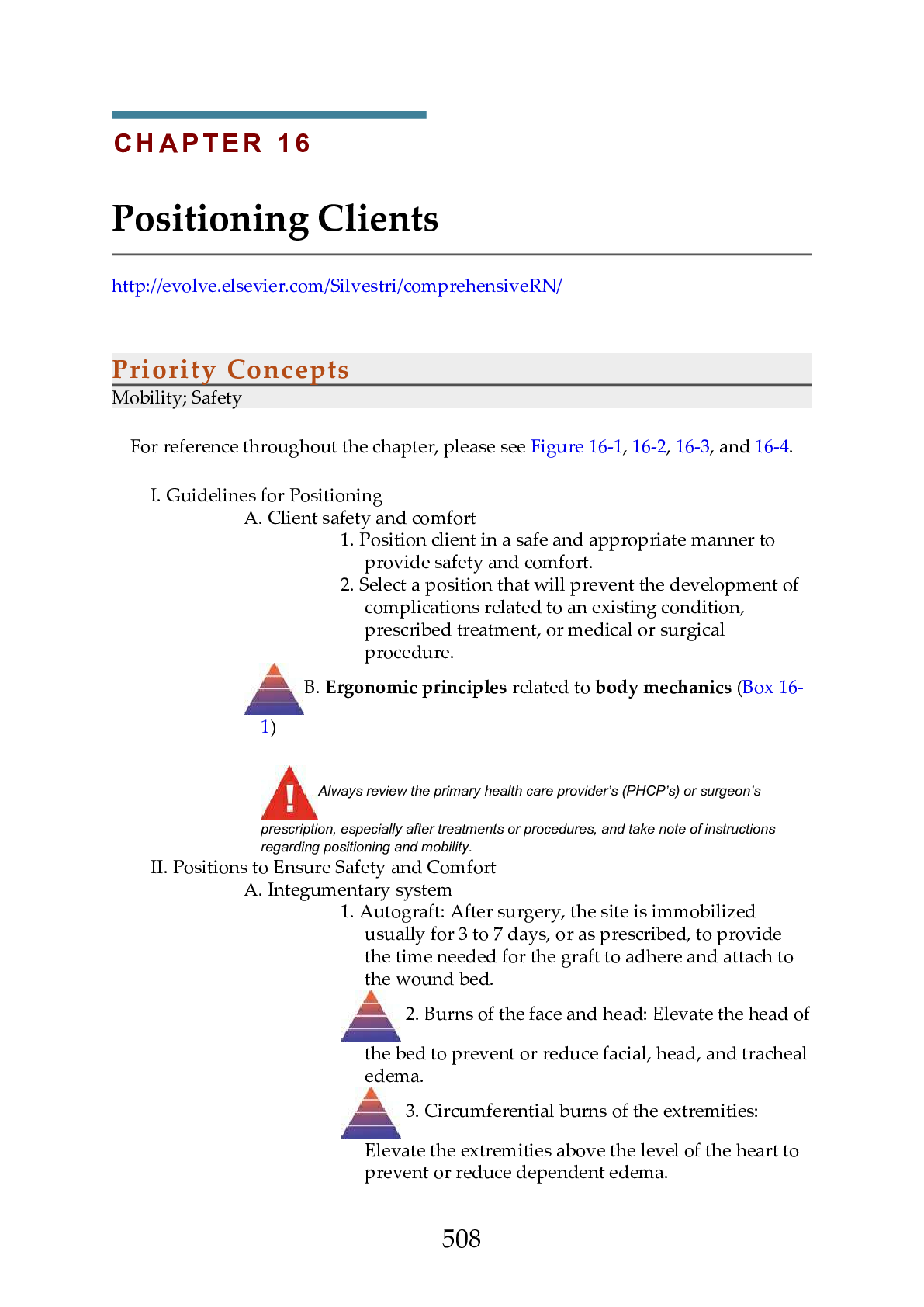
Reviews( 0 )
Document information
Connected school, study & course
About the document
Uploaded On
Oct 22, 2020
Number of pages
22
Written in
Additional information
This document has been written for:
Uploaded
Oct 22, 2020
Downloads
0
Views
81


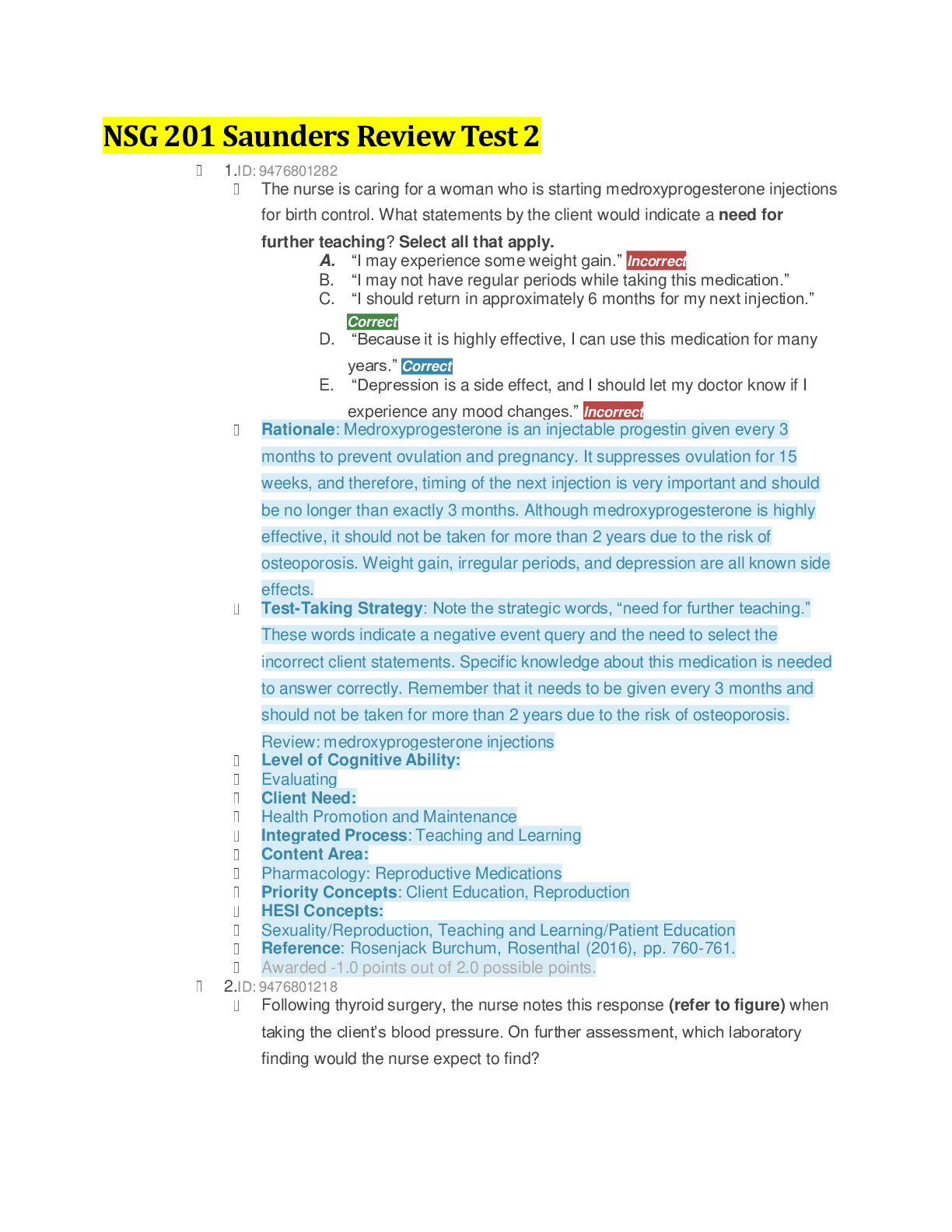

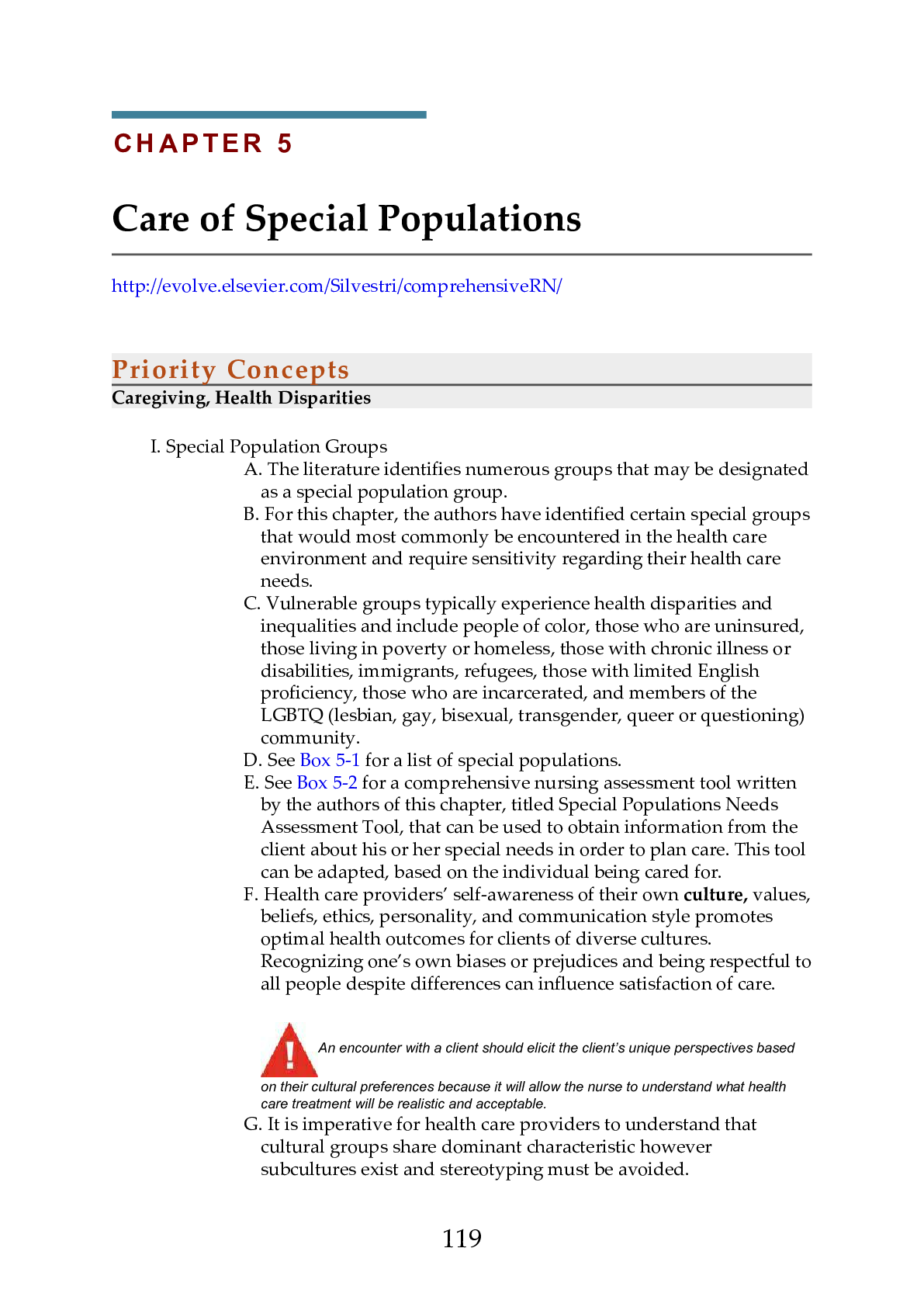

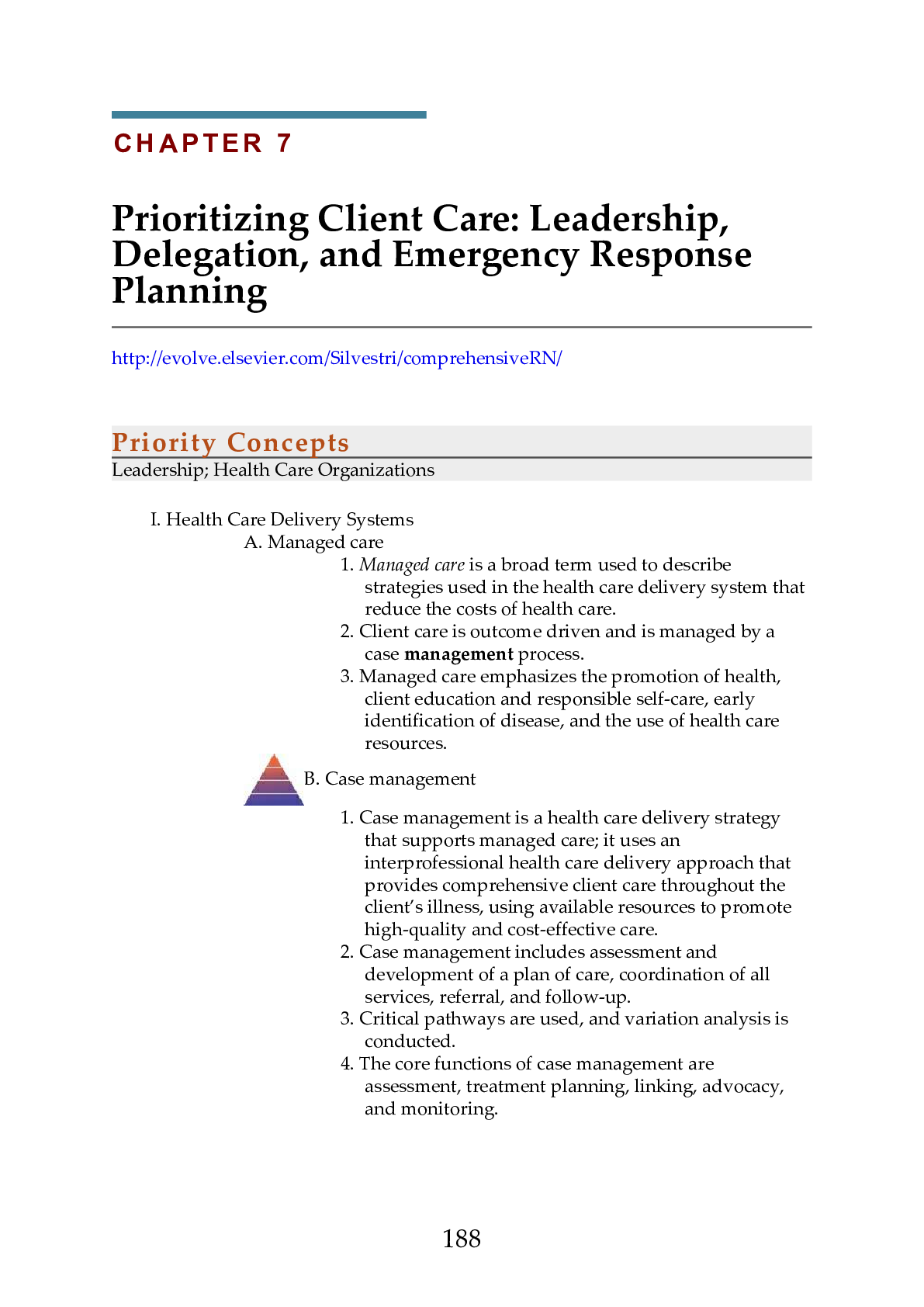

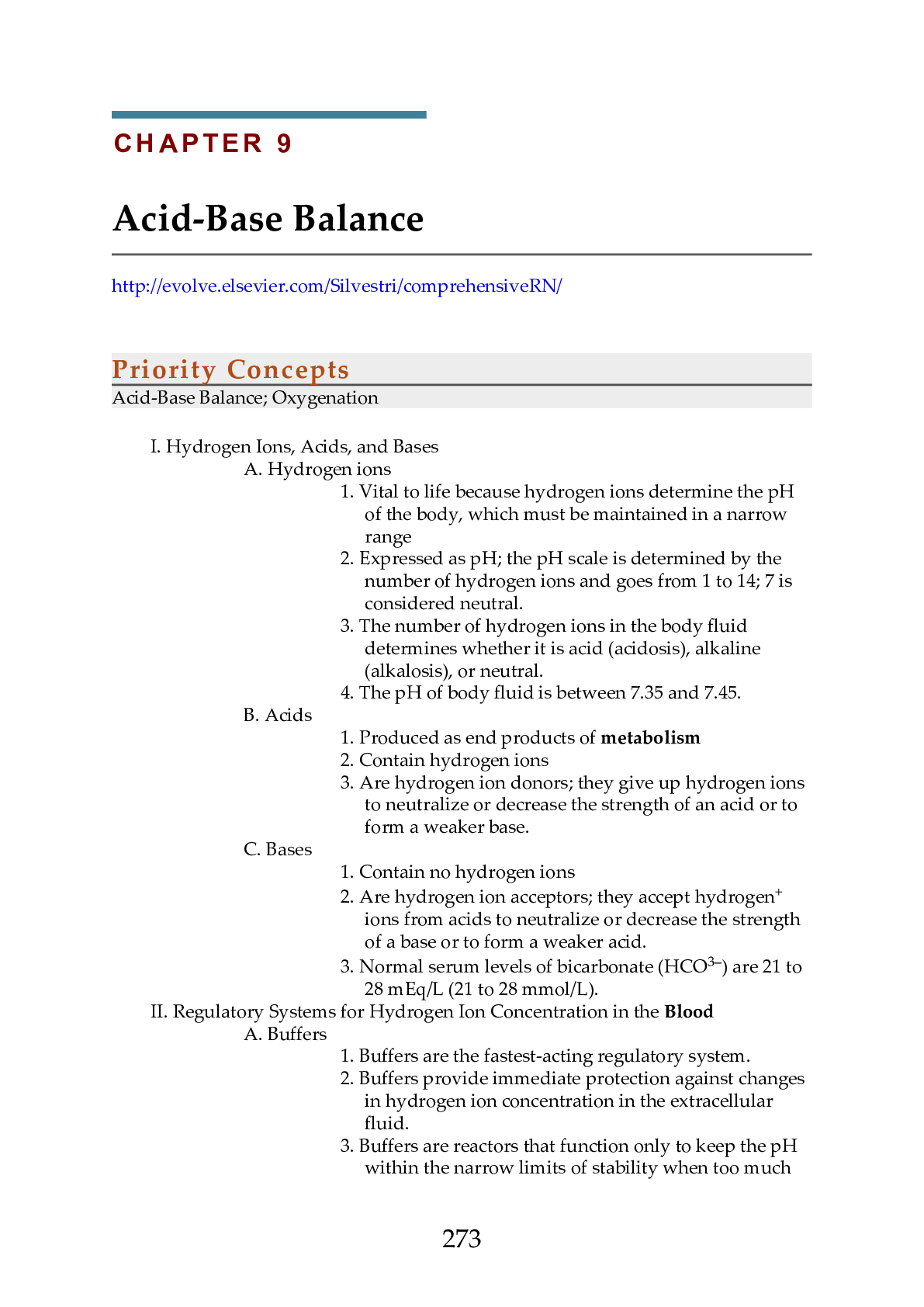



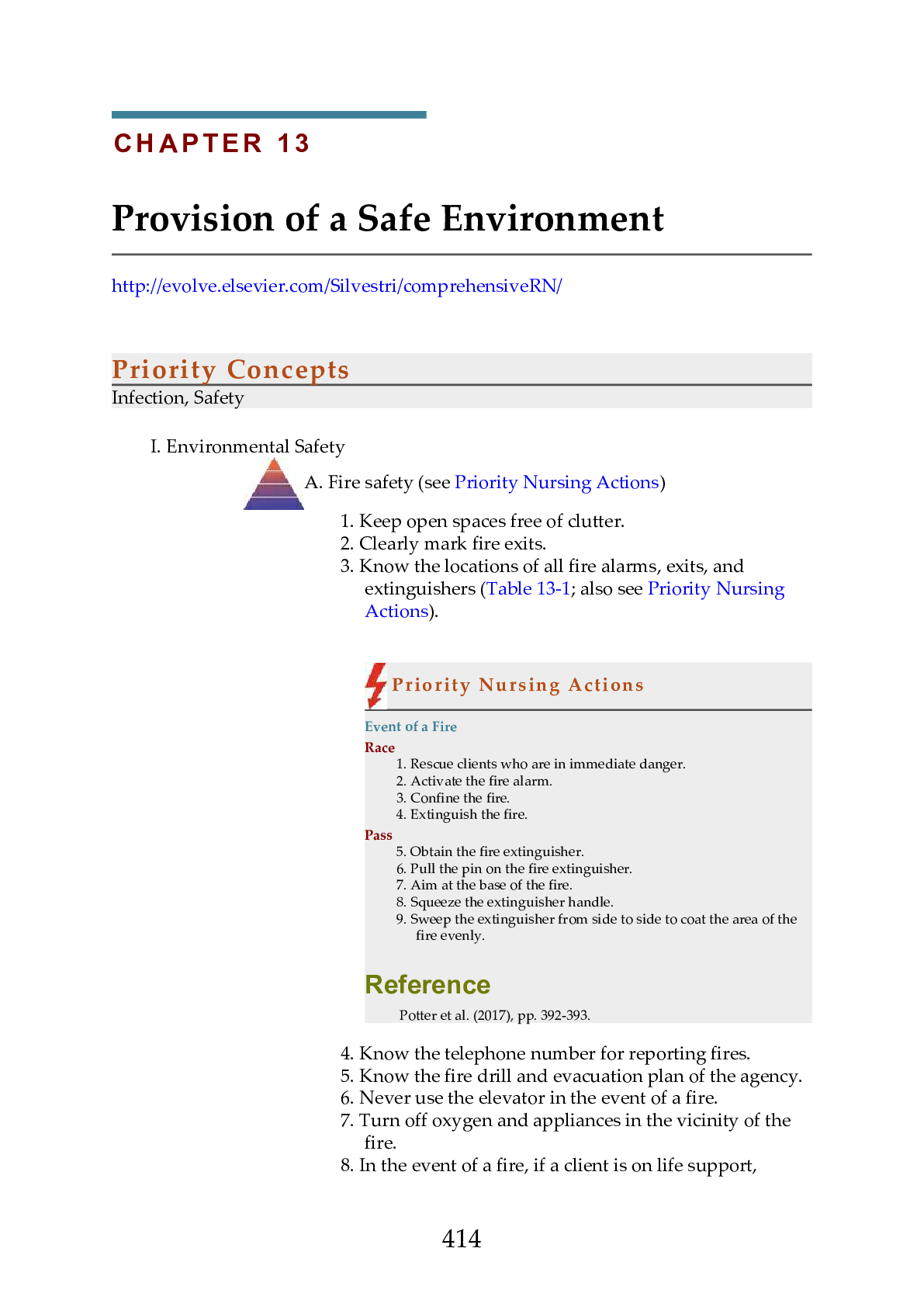




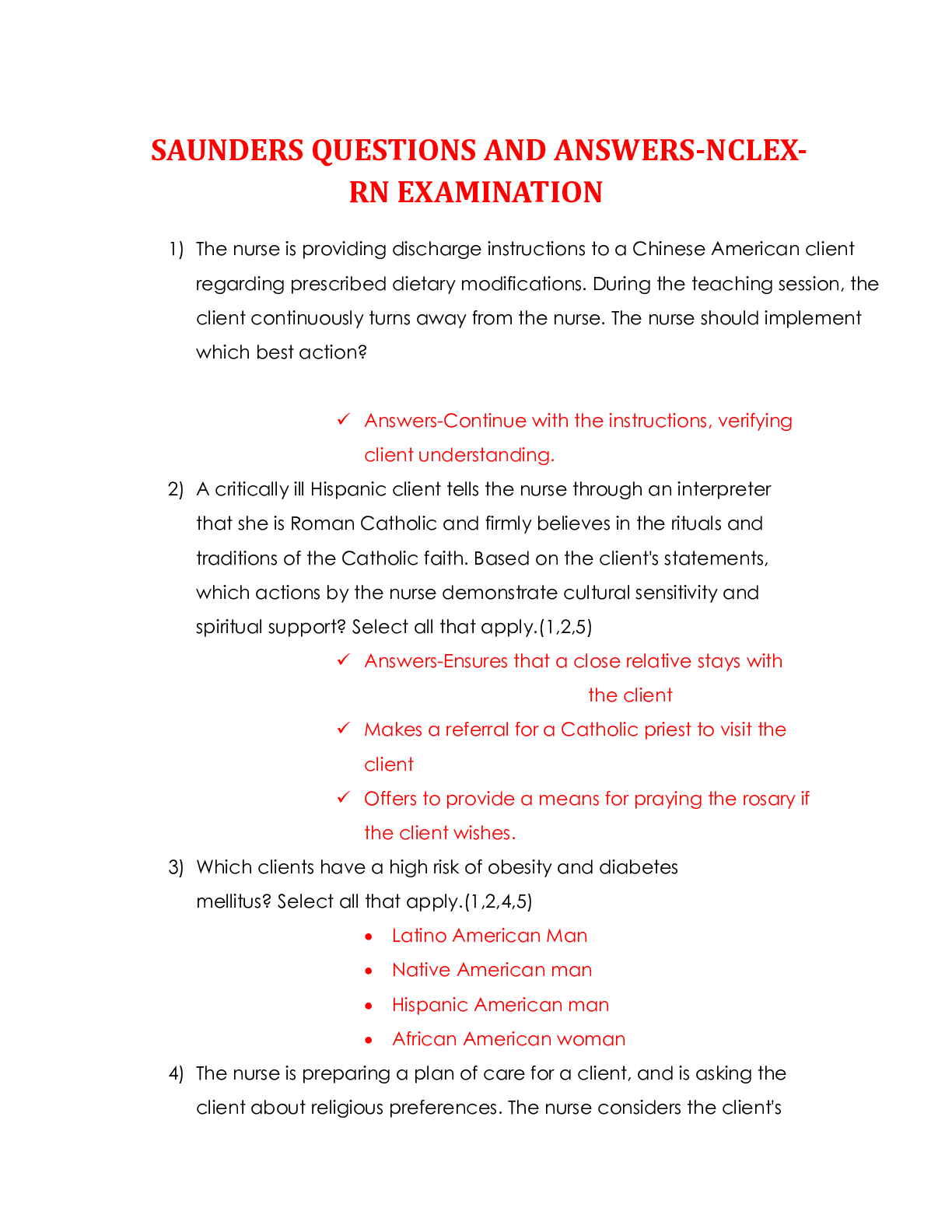

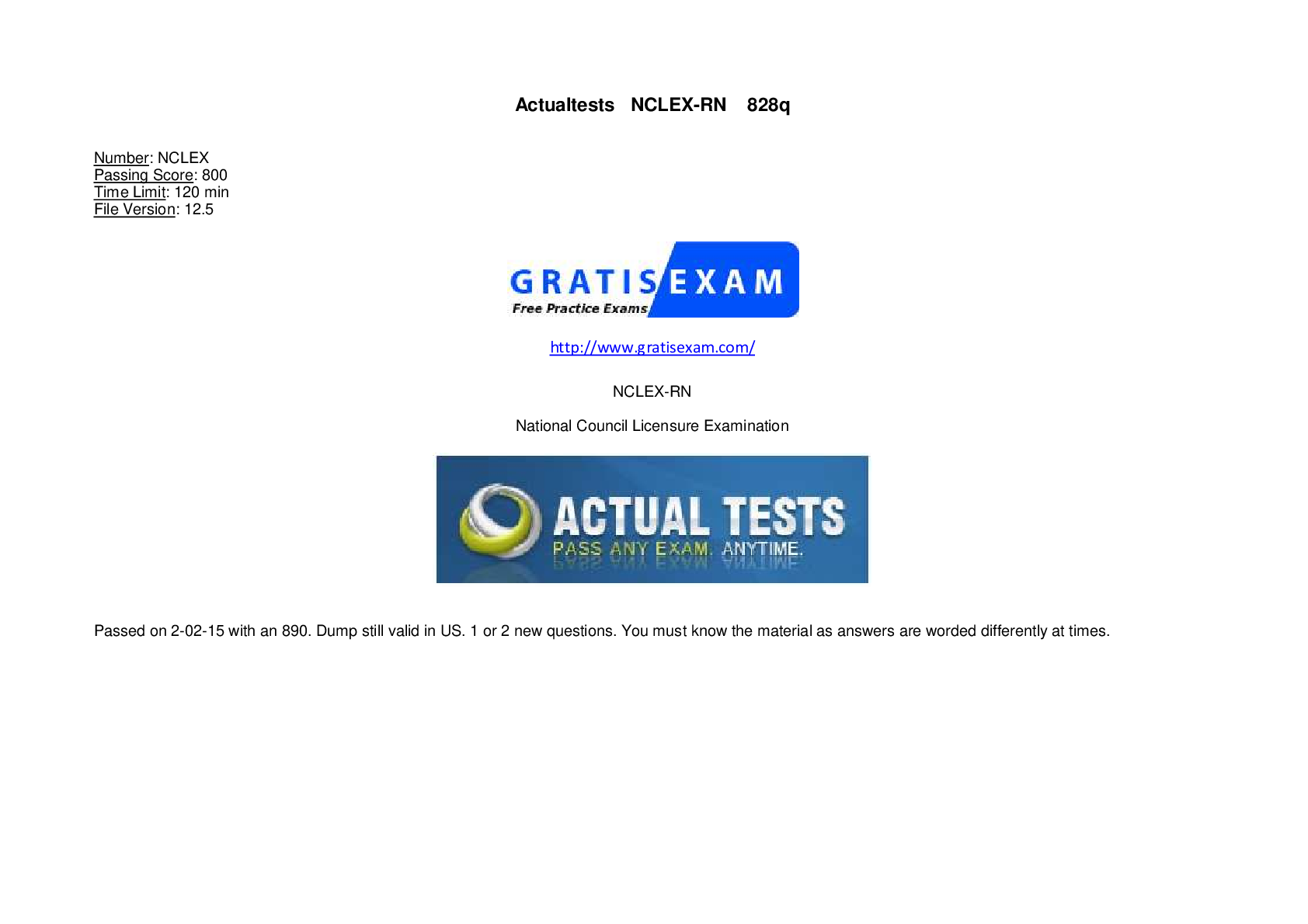
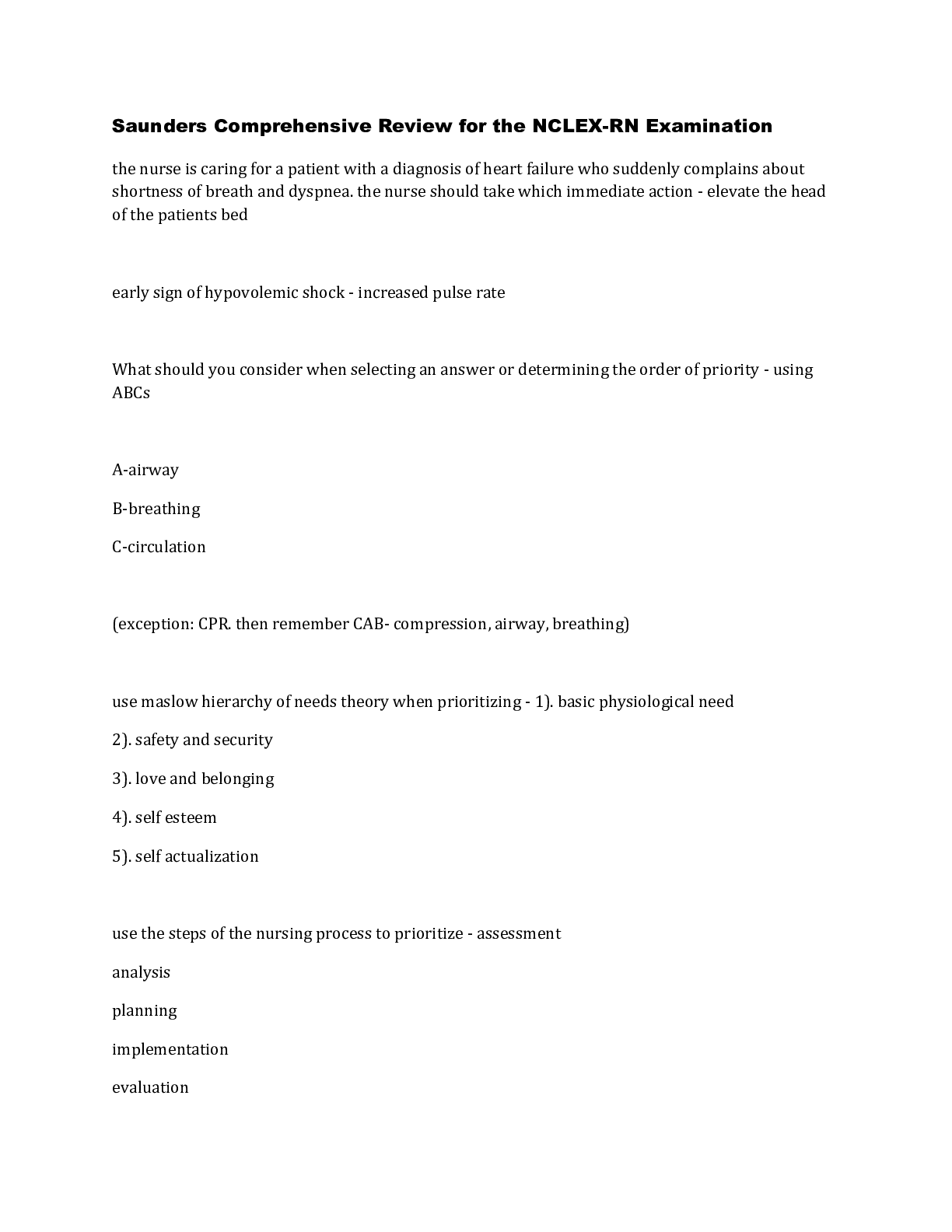





 With 850 Questions And Answers Guaranteed 100% Grade A.png)
